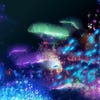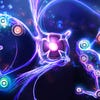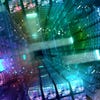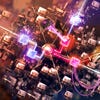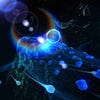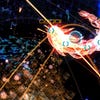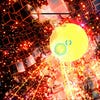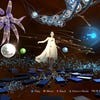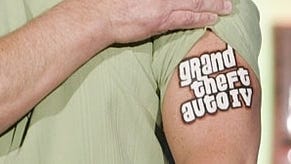Child of Eden
Adam and Eve it.
So instead of a soliloquy, we get a space whale. Your lock-on fire turns the hot barnacles on its back to glittering jewels. Coat the creature in a blanket of diamonds and it tears off into the Milky Way, disintegrating into a shower of gems that dissipate into nothingness before reassembling as a swooping phoenix. Shoot this creature's wings and bloom-effect feathers scatter. Aim at the red sphere beating at its centre and Lumi herself flashes up onto the screen, crying out in pain and euphoria as her memory is, shot by shot, realised, redeemed.
Later, in the industrial world of Passion where giant cogs clank overhead, a steam train rattles past, morphing into a high-speed bullet train as you evolve it with your transformative bullets. If Rez was an excursion through a series of abstract shape landscapes, Child of Eden is an out-of-body tour through human history, cherry-picking moments in humanity's rise from ocean depths to rocket ships: snapshots that are far from comprehensive, but curiously cohesive all the same.
If you want the full-body physical experience - feeling part of the music, sweeping your arms like a conductor in wide arcs that call the timpani section to action at your signal - then Kinect is the way to play Child of Eden. With the lights down low and the right ambiance and mind-set, it's a dance-like experience - but not in the orthodox video game understanding of Simon-says rhythm-action routines.
Rather, you move with the light and music and as the chords rise wave after heightening wave; it's close to a transcendent experience, the kind you might have alone in a 2am club, or atop a mountain at sunrise with your headphones on. Play the game for a while and you'll unlock 'Feel Eden', a non-difficulty level in which you are free to motion your way through its soundscapes, impervious to attack. Perhaps this is the peril-free Eden Mizuguchi always envisaged.
But once you've experienced the jaw-dropping sights on offer, the more gritty business of competition and completion begins. Within these parameters, Child of Eden is indisputably best played like Rez: with a controller. The accuracy of the analogue stick combined with the short jabbing motions required to switch between shot types make this a more precise, controlled experience.
In particular, the Euphoria special move, which clears all enemy bullets from the screen, is practically unusable with Kinect as it's triggered by holding both hands aloft - a motion that also hauls the camera upwards and away from the action with a nauseating lunge. With a standard controller, however, Euphoria works like a standard smart bomb.
The five basic worlds are challenging, and unlocking the next in sequence isn't merely a case of completing the previous journey but of amassing enough performance stars. As such, you'll need to play and replay each stage in order to win progress, a demand that some may find harsh and off-putting. But these stages, songs and visuals comfortably bear repeating, revealing their secrets with slow but dependable regularity. The kinetic and musically eclectic sixth world Hope, unlocked when you complete the others, is a worthy pay-off.
As with all of Mizuguchi's work, Child of Eden offers a memorable journey and a strong sense of development. But where Rez was concerned with the evolution of the player character, which transformed from amoebic blob to running man, the auteur's latest is about the evolution of the world around the player.
It leaves you with a peculiar sense of power: it feels as though you have the influence of a redemptive god, restoring a fallen world back to its Eden state after a corrupting virus. A splay of the fingers and what is broken is repaired, what is begun is finished. Alpha and Omega. Grasp and splay.




